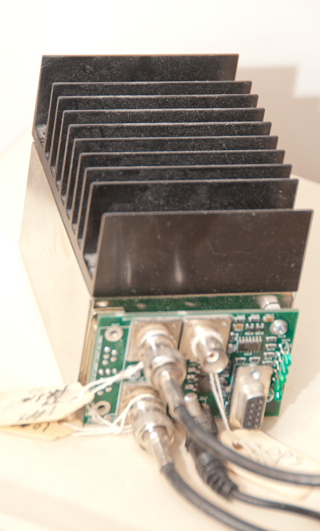Stanford Research Systems
PRS10
Rubidium Frequency Standard
© Brooke Clarke 2000 - 2007

256 seconds after connecting the 1 PPS from the Motorola Oncore VP the PRS10 automatically locks it's 1 PPS output to the GPS 1 PPS (and aligns the rising edges of the 1PPS signals) and uses the GPS long term stability to discipline the Rb. See the sales brochure for a plot showing the Root Allan variance of GPS alone, the Rb alone and the two combined.
I also have the optional heat sink that mounts to the base of
the PRS10 and has a hole to allow access to the freq. adj.
pot. (Although it is disabled when an external 1 PPS is
applied.)
Somehow I killed the 7404 SMT IC on the origional PRBB and was
able to replace the IC. It blew a second time but I was
not able to make a second repair, but someone else bought the
board and did repair it using professional tools. My
second PRBB is working OK now. I have added a small Pomona
box to the test equipment end of the 50 Ohm coax cable that has
both a series 1 k Ohm resistor and a shunt 1 Meg Ohm resistor.
The series resistor is extra protection for a capacitor
that may be charged inside of some test equppment (it works
aginst the capacity of maybe 15 feet of coax) and the 1 Meg Ohm
resistor will bleed off any static buildup that may occur on the
coax if it becomes disconected from the PRS10.
Mouser carries a Phihong 552-PSS-45W-240 45 Watt power supply for$37.60 that has the correct 2.1x5.5mm plug to connect directly to the PRS10 power socket. They also have the IEC EN603020/C7 line cord as Mouser # 173-21101. This is typically the 2 wire cord used for Laptop AC power modules.Have been using the Phihong power supply instead of the HP lab supply in order to free up the HP. The down side is that the PRS10 shuts down during a power failure, but that's OK since all the other test equipment alos shuts down.

I have started to write some LabVIEW code to work with the PRS10.
A plot of the Frequency Control word "FC" (22 bits) sent to the 10
MHz Xtal oscillator shows what that crystal is doing.
Remember it's output is always 10 MHz so that the changes in the
control word indicates what would have happened without the Rb
lock. You can easily see temperature and load
changes. Also for a number of hours after start up you can
see the Xtal settling into a stable state.
Frequency Synthesizer
This LabVIEW program now reads all the synthesizer parameters. Here is a screen shot (LV_Synth.jpg)Physics Package
Consists of:
- a 150 MHz oscillator to excite the Rb87 lamp with an output at about 780 nm The human eye can see about 400 (blue) to 750 (red) nm..
- a cell containing Rb85 & Rb87, an SRD to generate the electric field that sweeps through the very high Q hyperfine transition of Rb87 which is detected by a photo diode. Like a crystal the frequency (6.834,682,612,800 GHz +/-3E-9 ) depends on how it is manufactured. Pieter Zeeman won the 1902 Nobel prize for this Effect. "The Effect of Magnetisation on the Nature of Light Emitted by a Substance" P. Zeeman, Nature, vol. 55,11 February 1897, pg. 347
- Magnetic field to tweak the frequency of the Rb87 resonance so that with the synthesizer settings the unit will lock to exactly 10 MHz.
Here is a screen shot Phy.jpg showing the front panel of the LabVIEW program.
- separate temperature controllers for the lamp and cell.
Just to see the effect of Gravity on the 10 MHz crystal I rotated the PRS10 from heat sink fins up, to fins on the right, fins on the bottom, fins left and back to fins up. Here is the FC plot showing the movement. (Note that on the FC plot 1 count is close to 1E-12). FC_ROT.jpg
To support the newer bench top version of the PRS10, called the FS725, SRS has a free software package that reads all the parameters from the PRS10 or FS725 once each second. I use an Edge Port box with 4 serial ports that connects to the computer via USB, so am using COM5 for the PRS10 and the software supports this port.What they didn't tell you is to go into My Computer and set the COM port parameters for:
9600 Baud, 1 stop bit, No parity and Xon/Xoff protocol, if you don't do this it will not work.
A simple check is to type "ID?<cr>" into the message box and see if you get the ID string back.
Real Time plots of the performance of a PRS10. Driven from a Motorola UT+ with the latest firmware that has the sawtooth spike bug fixed.
When my house GPS antenna system quit working the PRS10 was not getting it's 1 PPS to steer the Rb, but becasue the aging rate for Rb is so much better than a crystal, I can keep using it as my house standard without the updates and still measure the aging rate of a crystal oscillator.
[an error occurred while processing this directive]This is the time
this page has been accessed since 28 Feb. 2000.